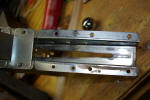My Judge Dredd had plenty of problems: one in particular was the ball trough.
It looked like it had been previously repaired with pliers, and was incapable of
reliable feeds. A previous owner had labeled the game to be used with 3 balls
only.
| |
|
 Here's
the outside of the trough, showing the wrinkle from a previous repair. Here's
the outside of the trough, showing the wrinkle from a previous repair. |
 And
the inside, showing the ball dimples. These dimples are made by balls
sitting in the trough. When a ball drains, it hits the top ball in the
pile. Every ball takes a little shock, some of which it passes on and
some of which it transfers to the softer trough material. Over time, the
trough develops perfect ball dimples that will hold balls back in
the trough. This holdback usually manifests itself as multiballs missing
balls. And
the inside, showing the ball dimples. These dimples are made by balls
sitting in the trough. When a ball drains, it hits the top ball in the
pile. Every ball takes a little shock, some of which it passes on and
some of which it transfers to the softer trough material. Over time, the
trough develops perfect ball dimples that will hold balls back in
the trough. This holdback usually manifests itself as multiballs missing
balls. |
 Here's
the outside from another angle. Here's
the outside from another angle. |
Normally, the dimples can be filed out with a small file at about 45
degrees to the edge of the trough. They don't have to be eliminated,
just blended in to allow the balls to roll smoothly. In this case, we
have the wrinkle to contend with. |
 The
Harbor Freight arbor press is a very handy tool. Here I am abusing it by
placing the bent-up trough bottom between the anvil and the post, and
hammering on the post. This process flattened out the nasty wrinkles
from the pliers repair. The dimples still needed to be filed out, but
the hammering also reduce the dimples. The
Harbor Freight arbor press is a very handy tool. Here I am abusing it by
placing the bent-up trough bottom between the anvil and the post, and
hammering on the post. This process flattened out the nasty wrinkles
from the pliers repair. The dimples still needed to be filed out, but
the hammering also reduce the dimples. |
 Here's
how we test the trough. The top of the trough should be level. The file
is there to raise the bottom to achieve that. Then we can roll balls to
see if the dimples and wrinkles are fixed. If the ball rolls smoothly,
and cannot be placed in any position other than the end, then we are OK. Here's
how we test the trough. The top of the trough should be level. The file
is there to raise the bottom to achieve that. Then we can roll balls to
see if the dimples and wrinkles are fixed. If the ball rolls smoothly,
and cannot be placed in any position other than the end, then we are OK. |
 Here's
the trough after hammering and filing, followed by emery papery then
some wet or dry. The wrinkles are gone. Here's
the trough after hammering and filing, followed by emery papery then
some wet or dry. The wrinkles are gone. |
 Side
view. Much better! Side
view. Much better! |
 Here's
the inside of the trough. Ugly, but functional. the balls roll freely
and do not hang up. Here's
the inside of the trough. Ugly, but functional. the balls roll freely
and do not hang up. |
 Installed
in the machine. Note the auto ball stop, which prevents balls from
falling out when the playfield is raised. Installed
in the machine. Note the auto ball stop, which prevents balls from
falling out when the playfield is raised. |